Tag: Tar River
Sanitary Sewer Overflows
March 29, 2023
Sanitary Sewer Overflows

Sanitary sewer systems collect and transport domestic, commercial and industrial wastewater, as well as limited amounts of stormwater and infiltrated ground water to treatment facilities for appropriate treatment.
Occasionally, sanitary sewers will spill raw sewage. These types of spills are called sanitary sewer overflows. SSOs can contaminate our waterways, causing serious water-quality problems and back up into homes, causing property damage and threatening public health.
How? Well, raw sewage carries bacteria, viruses, parasitic organisms, intestinal worms, molds and fungi. As a result, it can cause diseases ranging in severity from mild gastroenteritis (causing stomach cramps and diarrhea) to life-threatening ailments such as cholera, dysentery, infections hepatitis and severe gastroenteritis, according to the EPA website.
In the Neuse and Tar-Pamlico watersheds, the main cause of SSOs is predominantly stormwater and/or groundwater overloading a system during tropical weather events, or even a hard rain. Aging sewer infrastructure and new development creating an additional burden on already insufficient infrastructure also contribute to our SSOs. When you have many municipalities, and municipal sewer systems, along the banks of your rivers, the chance that something will go wrong — a pump breaks, a blockage occurs — increases exponentially, as does the chance pollution will pour into our waterways, thousands of gallons at a time.
All that bad stuff entering our rivers, lakes, streams or brackish waters can impact water quality — and not for the better. If we can’t use waterbodies for drinking water, shellfish harvesting, fishing or recreation, that’s a loss: SSOs can close beaches; tourism and waterfront home values may fall; fishing and shellfish harvesting may be restricted or halted.
So how can SSOs be reduced or eliminated?
Investment. According to the EPA, our nation’s sewers are worth a total of more than $1 trillion. Sewer rehabilitation to reduce or eliminate SSOs can be expensive, but the cost must be weighed against the value of the collection system asset and the added costs if this asset is allowed to further deteriorate. Ongoing maintenance and rehabilitation add value to the original investment by maintaining the system’s capacity and extending its life.
What can we do to reduce SSOs? Don’t pour fats, oils or grease down the sink, and don’t flush household items such as baby wipes, facial wipes, sanitary pads and tampons down the toilet—all can contribute to blockages in the system.
Let’s not forget about septic systems, too. If not installed and maintained properly, a septic system can contaminate surface and/or groundwater. If you have a septic system, learn how you can protect local surface water here.
Latest News

Smithfield sewage spill investigation continues
September 26th 2024

Riverkeeper: 'We suspect sewage is flowing directly into the Neuse'
September 11th 2024

Sound Rivers staff investigating Smithfield sewage issue
August 29th 2024

TS Debby sewage spills in Rocky Mount climbs to 14
August 22nd 2024
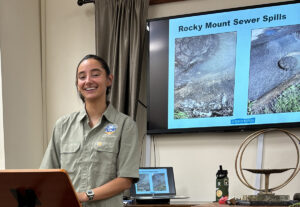
Sewage the subject of Riverkeeper presentation
August 22nd 2024
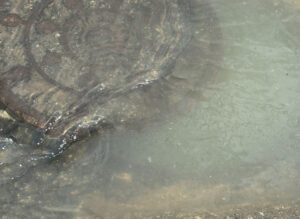
Storm spurs slate of sewage spills
August 15th 2024

Riverkeeper monitoring Rocky Mount spill site, pre- and post-Debby
August 8th 2024

Riverkeeper tracking Rocky Mount sewage spills
August 1st 2024

Havelock experiences largest spill yet
March 7th 2024
CAFOs
March 28, 2023
CAFOs

Swine CAFOs
Among the biggest threats to water quality in both watersheds — and particularly in the lower Neuse — is large quantities of nutrient pollution, especially nitrogen and phosphorus. This type of pollution comes from a variety of sources: runoff from large areas that contain fertilizers, animal waste washed from lawns, urban developed areas and farm fields among them.
However, industrial meat production facilities, including swine and poultry facilities housing tens of thousands of animals, contribute most of the excess nitrogen and phosphorous discharging into our rivers and streams.
These facilities are called CAFOs, which stands for concentrated animal feeding operations. In North Carolina, hogs outnumber people in 30 of 100 counties, many of them rural — many of them in the Neuse and, to a lesser extent, the Tar-Pamlico watersheds. Many of them are located near or in disproportionately low-income and communities of color. And some of them are located on the banks of waterways, in eastern North Carolina floodplains.
Where a concentrated number of animals are being housed and fed, the animals are also producing waste — and a lot of it. It’s estimated that hogs put out about 10 billion gallons of waste each year, and that’s just in North Carolina. Hog waste is stored in “lagoons,” some of which are not lined, and waste can, conceivably, make its way into groundwater by soaking through the soil.
The way hog waste is disposed of is by siphoning it from the lagoon into a truck with a sprayer, and spraying the waste onto fields. This, in itself, is problematic. Spraying fields with waste can affect the air quality of neighboring communities — not only creating an awful stench, but airborne particles from this practice have been proven to have a negative impact on human health with consistent exposure. And when it rains, hog waste on fields potentially becomes stormwater runoff from those fields, washing into ditches, streams, creeks and rivers — thus, the excessive nutrients.
Some nutrients like nitrogen and phosphorous can be beneficial to aquatic life in small amounts, but large amounts can contribute to excessive plant growth, algae blooms and low levels of dissolved oxygen in the water. All that often adds up to fish kills, in which hundreds, if not thousands, of fish die and decay and add a bunch of bacteria to the mix. Nobody wants to swim or boat with dead fish. No one wants to eat a fish with sores, either.
Here’s another effect of climate change: heavier rains mean more excess nutrients are washing into the waterways. More frequent tropical storms and hurricanes pose an even greater threat to water quality, as floodwater surrounds or inundates barns full of animals and lagoons full of waste. When that happens, the earthen berms surrounding the hog lagoons may fail, spilling millions of gallons of raw sewage into the waterways, and those heavy rains can fill a lagoon until the combination of rainwater and hog waste spills over the top.
That’s exactly what happened during Hurricane Florence in 2018. In North Carolina, 46 hog waste lagoons were flooded and another 60 spilled over, and all of that waste ended up in the waterways.
Poultry CAFOs
In the past two decades, North Carolina’s poultry industry has exploded.
However, because the industry only reports to the North Carolina Department of Agriculture, there is no public record of how many of these facilities exist or even where they are.
North Carolina’s poultry industry is growing and largely unregulated, which makes it nearly impossible to understand the environmental impact it’s having on our waterways and communities.
Riverkeepers’ only way to determine the number and location of poultry facilities is to cobble together information from limited statements given by state agencies, what’s in the news, and by actually flying over facilities and scouting them out themselves.
Like swine CAFOs, poultry CAFOs produce a lot of waste every year. The method of disposing of poultry waste is to remove the dry litter from the confinement buildings, where it is stored outdoors in large piles before being used locally as fertilizer on pastures and hayfields or shipped out of the area for use as fertilizer elsewhere.
It is when the dry litter — a mix of poultry waste, spilled feed, feathers and material used as bedding — is stored outdoors, particularly if left uncovered, that it poses a threat to water quality.
A good rain on an average day can readily wash dry litter into nearby ditches, streams, creeks and rivers. During a hurricane, it’s much worse. For example, in 2018, 35 poultry facilities in eastern North Carolina were flooded during Hurricane Florence; more than 3.4 million poultry were killed, according to the poultry industry. Considering that each facility holds tens of thousands of birds, that’s an enormous amount of waste poisoning local waterways and aquatic life.
Latest News
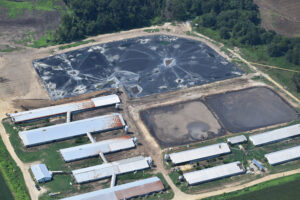
In foreclosure, biogas facility still racking up violations
September 26th 2024
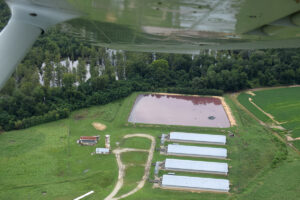
Riverkeeper goes airborne to check CAFOs post-storm
August 15th 2024
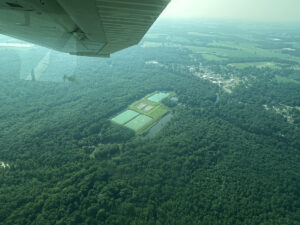
Riverkeeper: What goes up, must come down
July 18th 2024

Riverkeeper responds to Swift Creek spill, CAFO violations
May 16th 2024

Sound Rivers investigates Swift Creek hog waste spill
May 2nd 2024
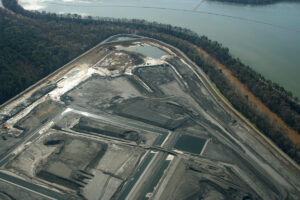
Flight an education on coal ash cleanup
March 14th 2024

Riverkeeper win: White Oak must close existing hog-waste lagoons
December 14th 2023

ACTION ALERT: NCDEQ permits need OUR input!
October 26th 2023

Riverkeeper introduced to aerial investigation
October 26th 2023
Watersheds
March 28, 2023
Watersheds
Tar-Pamlico River Basin

The Tar River begins as a freshwater stream in the Piedmont near Roxboro, flowing east to become the Pamlico River near Washington, then draining into the Pamlico Sound before meeting the Atlantic Ocean. Major tributaries in the upper basin include Swift, Fishing and Tranters creeks and Cokey Swamp, as well as the Pungo River in the lower basin. It also includes Lake Mattamuskeet, home to Mattamuskeet National Wildlife Refuge and, at more than 18 miles long and six miles wide, is the largest natural lake in the state.
The Tar-Pamlico River Basin is made up mostly of wetlands and forested areas covering about 55% of its area, with about one-quarter made up of agricultural land and a small portion of urban, developed areas. This basin is rural when compared to the Neuse, which is similar in size and hydrology.
A gateway to the coast, the Tar-Pamlico feeds into a highly productive estuary that is a nursery for more than 90% of all the commercial seafood and recreational fish caught in North Carolina. The Albemarle and Pamlico sounds comprise the second-largest estuary system in the United States.
Sadly, the Pamlico River has been plagued with environmental problems. Excessive growth of algae and increasing numbers of diseased and dying fish over the past two decades suggest a decline in water quality. Municipal treatment plants that discharge wastewater into rivers and streams and runoff from nonpoint sources, such as farmland, timber operations and urban areas, also contribute pollution. These sources increase levels of the nutrients in the watershed — primarily nitrogen and phosphorus – resulting in an unbalanced ecosystem.
Neuse River Basin

The longest river in North Carolina, the Neuse River stretches 248 miles from the Falls Lake Reservoir Dam in the Piedmont to its mouth at the Pamlico Sound and the state’s first capital of New Bern. At its mouth, six miles across, it’s the widest river in U.S. and part of our nation’s second-largest estuary. Major tributaries include Crabtree, Swift and Contentnea creeks and the Eno, Little and Trent rivers. The Neuse River Basin is a critically important body of water for nearly one-sixth of the state’s population.
Among the biggest threats to water quality in the lower Neuse River are large quantities of nutrient pollution, especially nitrogen and phosphorus.
Nutrient pollution is a form of water pollution, in which water is contaminated by excessive inputs of nutrients.
This type of pollution results from: runoff from large fertilized areas (such as golf courses), urban developed areas and farm fields treated with fertilizer, pesticides and herbicides; animal waste washed from lawns; and industrial meat production facilities discharging into our rivers and streams. Swine concentrated animal feeding operations (CAFOs), for example, contribute 60% of the excess nitrogen and phosphorus.
Some nutrients can be beneficial to aquatic life in small amounts, but large amounts can cause excessive plant growth, algal blooms and low levels of dissolved oxygen in the water.
To a lesser degree, water quality in the Neuse River Basin is being affected by pollution from more than 400 industrial and municipal sites that are allowed by state permit to discharge treated wastewater into streams and rivers. Both of the above situations can be harmful to fish and other aquatic life.
Latest News

Trash traps get holiday cleanouts!
December 19th 2024

Underground cistern a first for Sound Rivers
December 19th 2024

Campus Stormwater takes on Northern Nash
December 19th 2024

Progress on Smithfield pollution problem
December 19th 2024
Attorney Marvin Horton on IBP Slaughterhouse
December 18th 2024

Sound Rivers launches Stormwater Education Week
December 12th 2024

Riverkeeper talks Neuse issues with Wayne students
December 12th 2024

Riverkeeping team hosts Muddy Water Watch training
December 12th 2024

Lenoir Science Club tackles trash trap cleanout
December 12th 2024
Riverkeepers
March 28, 2023
Riverkeepers
Samantha Krop
Neuse Riverkeeper

“I grew up swimming, boating and kayaking in the brackish waters and swamps and have always, always, been in love with rivers. … I’m honored to be working with the people of the Neuse to advocate for the river and all those who rely on it.”
Samantha Krop is the Neuse Riverkeeper, Sound Rivers’ advocate for the health of the Neuse and its many tributaries, from Durham to Havelock. Sam came to Sound Rivers from Oregon, where she served as the coalitions coordinator for the Forest Waters Coalition, a network of conservationists and community members working together to create stronger protections for Oregon’s forested watersheds. Prior to her full-time role as a coalitions builder, she taught undergraduate- and graduate-level courses in environmental justice and pedagogy at the University of Oregon. A native of Florida’s Gulf Coast, Sam is no stranger to North Carolina rivers: she spent summers at Camp Celo on the shores of the South Toe River in the Black Mountains, a place where her love of nature and future career as an environmental advocate — guided by the central tenets of equity and inclusivity — was forged.
Sam currently serves on the Raleigh Stormwater Advisory Commission.
Sam can be reached at samantha@soundrivers.org.
Katey Zimmerman
Pamlico-Tar Riverkeeper

“Growing up, I always said that I wanted a career where I could make a difference, make an impact, and I’ve always had a love for the environment. The reason this is what I want to do is because I truly care about protecting the rivers and all of their natural resources, and sustainability as a whole.”
Katey Zimmerman graduated Magna Cum Laude with a degree in sustainability and coastal resilience from Coastal Carolina University in Sound Carolina. Her background includes running the Swim Guide program for the Waccamaw Riverkeeper and coordinating outreach events, teaching children and adults about the watershed and how to protect it.
Originally from Pennsylvania, just north of Philadelphia, Katey was drawn to Coastal Carolina University’s outstanding marine sciences program. After taking a sustainability class as a freshman, her interest shifted, and when Coastal Carolina added a sustainability major the following year, her major did too. But it was when she began working with the Waccamaw Riverkeeper that she truly found her calling.
Katey can be reached at katey@soundrivers.org.
Mission
March 21, 2023
Overview
Sound Rivers is a private nonprofit organization that guards the health and natural beauty of the Neuse and Tar-Pamlico River Basins. We partner with concerned citizens to monitor, protect, restore and preserve the watersheds covering 22% of North Carolina’s land mass in order to provide clean water to our communities for consumption, recreation, nature preservation and agricultural use.
Founded in 2015 with the merger of two of the state’s oldest grassroots conservation organizations, Sound Rivers combines the deep history of advocacy of the Neuse River Foundation, established in 1980, and the Pamlico-Tar River Foundation, established in 1981. This union to become Sound Rivers creates a powerful advocate protecting our most cherished waterways and bolsters our impact within the State of North Carolina.
Our three full-time Riverkeepers® monitor and protect the Neuse and Tar-Pamlico River Basins, serving as scientific experts and educational resources to schools and communities living in the watershed.
Your Support Protects Our Rivers
We are a grassroots organization supported by individual and corporate grants and tax-free donations. Sound Rivers is both the watchdog of the rivers and lifeblood of the people and communities that rely on this watershed. For more than 35 years the combined organizations have monitored and protected our rivers through:
- Education about environmental impacts to our natural surroundings.
- Advocacy for enforcement of existing laws.
- Development of new legislation to protect the health and natural beauty of our state.
- Conducting research that monitors and evaluates river health.
Our Mission
To monitor and protect the Neuse and Tar-Pamlico River watersheds covering nearly one quarter of North Carolina, and to preserve the health and beauty of the river basin through environmental justice.

Pamlico Paddle
March 21, 2023
 They’re back …
They’re back …
Pamlico-Tar Riverkeeper Jill Howell and Environmental Projects Coordinator Clay Barber headed out Oct. 17 on another epic paddling adventure, this time, a five-day, 70-mile kayaking trip down the Pamlico River.
Sound Rivers staff and volunteers gathered at Havens Garden in Washington on Sunday for a land-based cleanup on the shores of the Pamlico and nearby creeks, followed by a send off of our intrepid paddlers from the Havens Garden boat ramp on Runyon Creek.
Jill and Clay are taking up where they left off on last October’s Tour de Tar, a 10-day trip from Oxford to Washington, paddling from Havens Garden in Washington to the public boat ramp in Swan Quarter. You can follow Clay, Jill and Jill’s first mate, Miller, (also known as the Adventure Pup) and their adventures here, or at @soundriversnc Facebook and Instagram.
Click on the links below to see what Jill, Clay and the Adventure Pup, Miller, have been up to!
| Thank you, sponsors, for you generous support! |
 |
 |
 |
 |
 |
 |
 |
Betsy & Joe Hester
Rick Zablocki Linda Boyer |
 |
BY SUPPORTING JILL AND CLAY’S PAMLICO PADDLE, YOU’RE SUPPORTING THEIR WORK ALL YEAR LONG!

Protect our wetlands
March 21, 2023
Protect our wetlands
NCDEQ SEEKS COMMENTS FOR TEMPORARY WETLANDS RULES
In April 2020, the Environmental Protection Agency and the U.S. Army Corps of Engineers issued a new rule eliminating federal oversight for millions of acres of wetlands and small streams. The Southern Environmental Law Center has estimated the rule resulted in a loss of federal protections for roughly 900,000 acres in the Cape Fear and Neuse river basins alone — much larger across the Coastal Plain as a whole, or statewide.
North Carolina has already lost more than 50% of our wetlands and those that remain are vital for absorbing stormwater and preventing flooding downstream, among the many other benefits they provide. READ MORE ABOUT THE IMPORTANCE OF WETLANDS HERE!
This month, the NC Environmental Management Commission (EMC) has proposed a new rule that would establish a state permitting program to protect our wetlands and manage flooding in our communities. Help us show the EMC that North Carolinians support protecting our wetlands by sending a letter today!
Wetlands and small streams play a critical role in filtering harmful pollution, protecting drinking water, sustaining our wildlife, and reducing flooding downstream. The proposal by the EMC fills a critical permitting gap created by the rollbacks of federal wetland protections.

Sound Rivers documentary explores past, present and future
March 21, 2023
Sound Rivers documentary explores past, present and future
Sound Rivers’ documentary premieres in the fall
We’re taking Sound Rivers’ story to the big screen!
Of the several projects currently underway to highlight Sound Rivers’ past 40 years of advocacy and education, one will tell its story visually, from its founding by two separate organizations to its work moving forward, through the voices of our storytellers: founders and partners, those fighting for clean water and the next generations of environmental advocacy.
Interweaving the common thread of community activism through the organization’s past, present and future, the documentary will unite viewers of all demographics in a common purpose: to be a part of the change.
Tackling this project is Washington native and filmmaker Rain Bennett, who has a mission to inspire people of all ages.
“I hope to inspire action — specifically from the Millennial and Gen-Z generations. I am aiming at the hearts of younger eastern North Carolina locals to take up the fight Sound Rivers began four decades ago,” Bennett said.
After several months of honing the narrative and recruiting our storytellers and experts to provide background and the science behind issues, Bennett began filming on March 31 with interviews of Dick and Becky Leach (instrumental in founding Pamlico-Tar River Foundation) and Doris Stith (community activist, who experienced the historical flooding of Princeville during Hurricane Floyd in 1999). He wrapped up filming on Aug. 13, with some amazing aerial footage of Pamlico-Tar Riverkeeper Jill Howell patrolling the Tar River.
“I honestly had no idea all the work Sound Rivers had done over the past 40 years. In my preliminary research, I’ve become so aware of the challenges they face — and that we all face — and the importance of their mission,” Bennett said. “To create this documentary means I get to do what I love, to help protect a place I love and fight for the people whom I love. I am forever grateful for that.”
In October, Sound Rivers will premiere the film during a virtual event. Stay tuned for details!
Be on the lookout for a sneak-peek: a trailer for the Sound Rivers’ 40th-anniversary documentary will be released soon!








